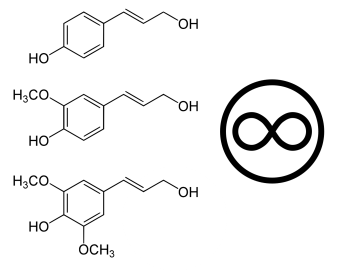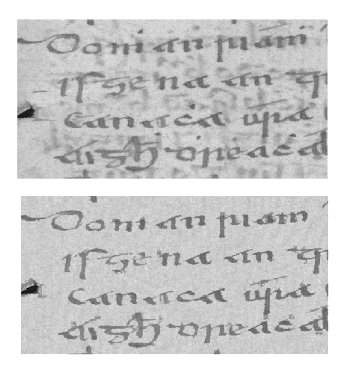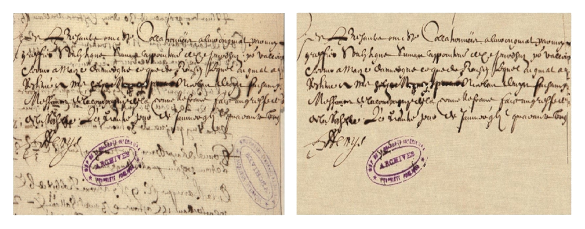Reading Old Manuscripts
May 15, 2023
Stone was used as a
medium for
permanent writing in
Egypt as early as its
Naqada II (Gerzeh) period, 3500 – 3200
BC. The permanance of this writing medium is evidence by
fragments that are
readable after more than 5,000
years. Similar permanence was achieved by
scribing cuneiform into
clay tablets at around the same
Bronze Age period.
Stone and clay offer permanance of writing, but their
texts are not that
portable.
Papyrus, introduced at about the same time during the
First Dynasty of Egypt, was a more portable medium. The permanance of papyrus texts was assured through the use of permanent
inks with
carbon black and
ochre pigments. The carbon black was obtained from
soot, and the ochre achieved its red
pigmentation through
ferric oxide (Fe2O3) that's also present in the
mineral,
hematite.

Three very ancient texts. Left, a portion of the Rosetta Stone, 196 BC. Center, a portion of the Book of the Dead papyrus, circa 1050 BC. Right, a clay tablet with cuneiform writing, circa 1525 BC. (Left, a Wikimedia Commons image by Nolde16. Center, a portion of a Wikimedia Commons image from the Rogers Fund, 1930, of the Metropolitan Museum of Art. Right, a Wikimedia Commons image by Gary Todd. Click for larger image.)
Parchment for writing appeared about a
millennium after papyrus. In the
5th century BC,
Herodotus (c.484-c.425 BC) writes in his
Histories that parchment was common in his time and had been in use for hundreds of years as a
substitute for papyrus when it was unavailable.
Pliny the Elder (c.23-79 AD), in his
Naturalis historia (Natural History) writes that
public documents were inscribed on
sheets of
lead, and
private documents were written on
linen cloth or
engraved on
wax tablets.[1]
Homer's Iliad alludes that tablets, presumably made from wax, were used before the time of the
Trojan War.[2]
Pliny
erroneously posits a date more recent to his time for the use of parchment at the
Library of Pergamum; viz.,
"Ptolemy prohibited the export of papyrus; upon which, as Varro relates, parchment was invented for a similar purpose at Pergamus. After this, the use of that commodity, by which immortality is ensured to man, became universally known."[1]
Today's print medium is
paper. The
papermaking process was invented in
China at around the
1st century. Paper started to replace papyrus around the
8th century, and papermaking reached
Europe in the
11th century where it replaced parchment. Paper was being produced on an
industrial scale in the
13th century, and in the
19th century,
wood replaced other
fibers, such as
cotton, in papermaking.
Wood-based paper was
inexpensive; and, as a
corollary to
Gresham's law, since print on wood-based paper appeared nearly identical to that on higher
quality papers, everything became printed on wood-based paper.
Wood pulp contains
lignin, which turns yellow,
brittle, and
deteriorates over time.
Acids used in the
pulping process accelerate this
ageing. As a consequence,
library collections were
crumbling by the early
twentieth century, and papermaking was modified to improve paper quality.
Today,
acid-free paper is produced without lignin or sulfur, and the acids in the wood pulp are
neutralized with a mild base, such as
calcium bicarbonate or
magnesium bicarbonate. A slight excess of bicarbonate provides a reserve against
environmental attack from
air pollution, and such
alkaline papers have a
lifetime of five hundred to more than a thousand years.

Left, the three common chemical components, called monolignols, of lignin , and the symbol for Permanent Paper.
Top, paracoumaryl alcohol, center, coniferyl alcohol, and, bottom, sinapyl alcohol.
The unicode for the Permanent Paper Sign in unicode is U+267E.
(Left images (modified) by Yikrazuul, and right image, both from Wikimedia Commons. Click for larger image.)
While the demise of paper, as in the
paperless office, has been
predicted for many
decades, paper use only started to significantly decline in the last decade. The
migration of
information to
digital data has its problems. While documents from thousands of years ago can still be read, it's unlikely that today's digital data could be read just a
century from now. Our
cultural heritage (including these
blog articles?) could be lost to
posterity.
Old documents are in various states of readability, and many
scientific techniques have been used to enhance their contents. These include
fluorescence microscopy,
infrared microscopy,
X-ray analysis, and
computer image restoration techniques. Common problems are
fading, and bleed-through from the
obverse of a page. A recent
open access paper in
PLOS, the Public Library of Science, presents a document restoration method for color manuscripts.[3]
Research team members are from the
GIK Institute, (Topi, Pakistan), the
Istituto di Scienza e Tecnologie dell'Informazione Alessandro Faedo (Pisa, Italy), the
University of Birmingham (Birmingham, United Kingdom),
iFahja Limited (United Kingdom), and the
National University of Computer and Emerging Sciences (Islamabad, Pakistan).[3]
One important aspect of this document restoration method is that
artificial intelligence is not involved; so, you can actually understand how the results are obtained. The method uses the information obtained from each
color channel at each
pixel, which could be the conventional red, green, and blue (
RGB), or these plus additional data from
infrared, etc., as available. These data form a feature
vector. The method involves reducing the size of the image
dataset by
principal component analysis and using a
Gaussian mixture model for the analysis. As they say, an interested
reader is referred to the original paper, in which the relevant
equations are given.[3]
More interesting than any of the
mathematics are examples of this method. As shown in the following figures, the approach works well for bleed-through removal and enhancement of degraded images.

An example of bleed-through removal.
Top, manuscript with bleed-through from the obverse of the page. Bottom, the restored image using the method of the PLOS paper.
Portion of fig. 2 of ref. 3, released under a Creative Commons Attribution License.

Restoration of a degraded manuscript. Left, the original manuscript. Right, a restored image using the method of the PLOS paper. (Portion of fig. 3 of ref. 3, released under a Creative Commons Attribution License. Click for larger image.)
References:
- Pliny the Elder, "The Natural History," John Bostock and H.T. Riley, Trans., Taylor and Francis, London, 1855, via Tufts University Project Perseus.
- Homer, "The Iliad," Samuel Butler, Trans., Longmans, Green and Co., New York, 1898, via Tufts University Project Perseus.
- Muhammad Hanif, Anna Tonazzini, Syed Fawad Hussain, Akhtar Khalil, and Usman Habib, "Restoration and content analysis of ancient manuscripts via color space based segmentation," PLoS ONE, vol. 18, no. 3 (March 22, 2023), https://doi.org/10.1371/journal.pone.0282142. This is an open access paper with a PDF file at the same URL.
Linked Keywords: Rock (geology); stone; media (communication); medium; permanent; writing; Egypt; Gerzeh culture; Naqada II (Gerzeh); Anno Domini; BC; fragmentology (manuscripts); fragment; readability; readable; year; scribe; scribing; cuneiform; clay tablet; Bronze Age; era; period; written language; text; portable; papyrus; First Dynasty of Egypt; ink; carbon black; ochre; soot; pigment; pigmentation; ferric oxide (Fe2O3); mineral; hematite; ancient history; written language; text; Rosetta Stone; Book of the Dead; Metropolitan Museum of Art; Gary Todd; parchment; millennium; 5th century BC; Herodotus (c.484-c.425 BC); Histories (Herodotus); substitute good; Pliny the Elder (c.23-79 AD); Naturalis historia (Natural History); government; public; document; sheet metal; lead; information privacy; private; linen; textile; cloth; engraving; engraved; wax tablet; Homer; Iliad; Trojan War; error; erroneously; posit; Library of Pergamum; Ptolemy VI Philometor; export; Marcus Terentius Varro; invention; invented; Pergamus (Crete); commodity; immortality; man; universal; universally; paper; history of paper; papermaking process; China; 1st century; 8th century; Europe; 11th century; industrial scale; 13th century; 19th century; wood; fiber; cotton; cost; inexpensive; corollary; Gresham's law; quality (business); pulp (paper); wood pulp; lignin; brittleness; brittle; wear; deteriorates over time; acid; pulping process; ageing; library; archive; collection; crumble; crumbling; 20th century; twentieth century; acid-free paper; neutralization (chemistry); neutralized; calcium bicarbonate; magnesium bicarbonate; environment (biophysical); environmental; chemical reaction; attack; air pollution; alkalinity; alkaline; service life; lifetime; chemical compound; chemical component; monolignol; symbol; Permanent Paper; paracoumaryl alcohol; coniferyl alcohol; sinapyl alcohol; unicode; Yikrazuul; Wikimedia Commons; paperless office; prediction; predicted; decade; migration; information; digital data; century; cultural heritage; blog; posterity; science; scientific; technology; technique; fluorescence microscopy; infrared microscopy; X-ray; analysis; computer; image restoration; photodegradation; fading; obverse; open access paper; PLOS, the Public Library of Science; research; GIK Institute, (Topi, Pakistan); Istituto di Scienza e Tecnologie dell'Informazione Alessandro Faedo (Pisa, Italy); University of Birmingham (Birmingham, United Kingdom); iFahja Limited (United Kingdom); National University of Computer and Emerging Sciences (Islamabad, Pakistan); artificial intelligence; channel (digital image); color channel; pixel; RGB color model; infrared; Euclidean vector; dataset; principal component analysis; Gaussian mixture model; reading (process); reader; equation; mathematics; page (paper); scientific literature; Creative Commons Attribution License.